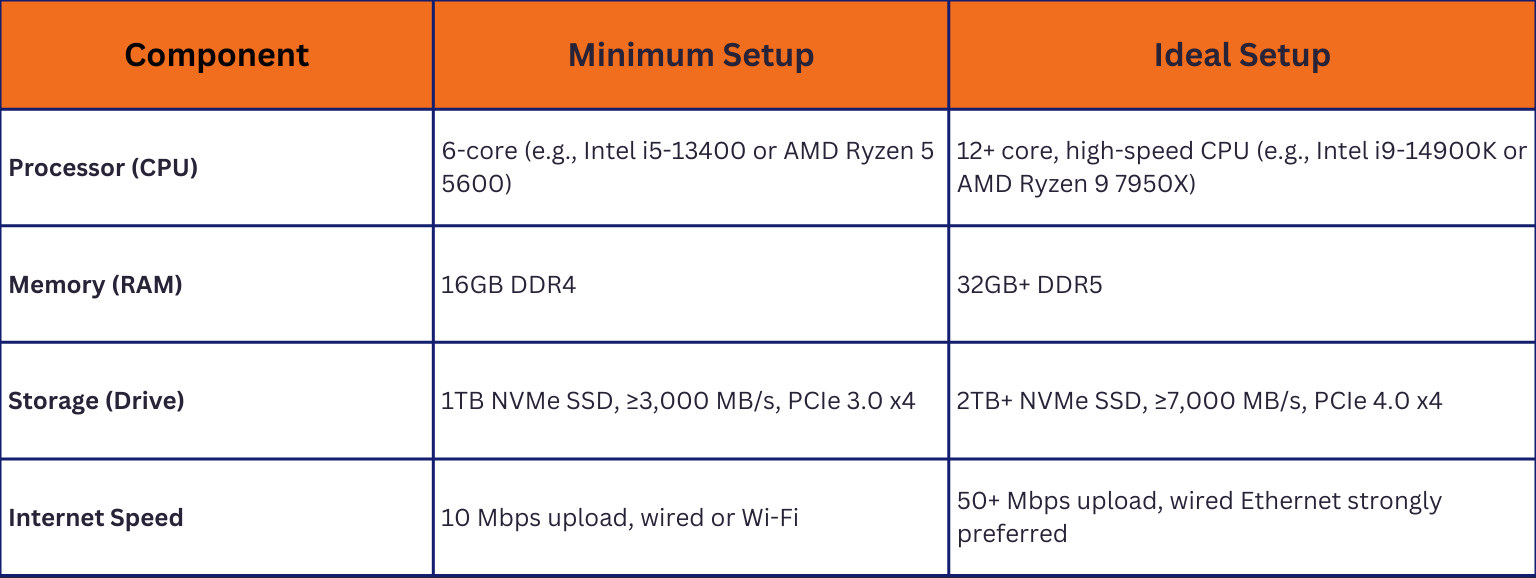If you’re working with visual media like photos, archives, or content at scale, you’ve probably noticed that performance matters. Whether you’re uploading photos to the MediaViz app, using our API behind the scenes, or just running media software in general, your computer setup can have a big impact on how quickly and smoothly everything works.
Understanding hardware requirements can be a challenge, so we created this guide with the help of our expert team members to give our recommendations on both minimum requirements (what you need to get by) and ideal recommendations (what will make your life easier, especially for high-volume or professional use).
Even if you’re not a technical person, this guide will give you the knowledge you need to shop smarter or talk to IT with confidence.
Processor (CPU): The Brain of the Computer
Your CPU, or Central Processing Unit, is what most people think of as the “brain” of your computer. It runs programs, manages tasks, and keeps things moving behind the scenes.
For tools like MediaViz, your CPU isn’t doing all the heavy lifting; it’s mostly helping organize your files, manage uploads, and make sure everything works together smoothly. But if your CPU is too slow or outdated, your computer can feel laggy or unresponsive during those tasks. A weak processor won’t crash the system, but it can make things feel sluggish, especially if you’re running other programs at the same time.
Minimum Recommendation
This level is fully functional for MediaViz and other AI-based image tools:
- CPU Tier: Modern 6-core processor
- Example Models:
- Intel Core i5-12400, i5-13400, or i5-14500
- AMD Ryzen 5 5600 or Ryzen 5 7600
These are often found in mid-range laptops and desktops released in the last 2 – 3 years.
Ideal Recommendation
For users managing high-volume uploads or wanting a faster, future-proof setup:
- CPU Tier: 12-core or higher with high clock speeds
- Example Models:
- Intel Core i7-14700K (20 cores), i9-14900K (24 cores)
- AMD Ryzen 9 7900 (12 cores), 7950X (16 cores)
RAM (Memory): Temporary Storage for Fast Access
RAM (Random Access Memory) helps your system handle active tasks. If your CPU is the brain, RAM is the workspace; it temporarily holds what your system is working on. More RAM allows you to move files, open folders, and run programs more smoothly, especially when working with large batches of images.
Minimum Recommendation
- Capacity: 16GB
- Type: DDR4
This is the minimum needed to avoid freezing, crashing, or excessive slowdowns when uploading or working with photos.
Ideal Recommendation
- Capacity: 32GB or more
- Type: DDR5
This gives you headroom for multitasking, larger datasets, and a generally smoother experience, especially if you use other tools alongside MediaViz.
Storage (SSD vs. HDD): Where Your Files Live
Your storage drive is where your files, software, and media are saved. There are two main types:
- HDD (Hard Disk Drive): Older, mechanical drives that are slower and more prone to wear
- SSD (Solid State Drive): Faster, modern drives with no moving parts
For any media-heavy workflow, SSD is strongly recommended. It directly impacts how quickly your files load, save, and transfer.
Minimum Recommendation
A reliable SSD that won’t bottleneck your upload speeds:
- Type: NVMe SSD (M.2 form factor)
- Capacity: 1 Terabyte (TB)
- Read Speed: 3,000 MB/s or faster
- Technology: PCIe 3.0 x4 or newer
You’ll usually find this setup in newer laptops labeled “performance” or “content creator” class.
Ideal Recommendation
For teams handling large volumes or factoring in future growth:
- Type: NVMe SSD (M.2 form factor)
- Capacity: 2TB or greater
- Read Speed: 7,000 MB/s or faster
- Technology: PCIe 4.0 x4 or newer
This eliminates storage as a bottleneck entirely and ensures your system runs smoothly even when handling large libraries.
Internet Upload Speed: The True Bottleneck
The most overlooked part of system performance is often the internet connection and upload speed. MediaViz and other AI systems process your images in the cloud, so a slow upload can dramatically affect performance, regardless of how powerful your computer is.
Minimum Recommendation
- Upload Speed: 10 Mbps (megabits per second)
- Connection Type: Wired or Wi-Fi
This is usable for basic workflows, but it may require you to leave uploads running for longer periods or plan your work around slow transfer speeds.
Ideal Recommendation
- Upload Speed: 50 Mbps or higher
- Connection Type: Wired Ethernet is strongly preferred, but wireless can work too
A fast, stable connection ensures large photo sets can be uploaded quickly and reliably, especially important for professionals or enterprise teams.
You can check your current upload speed for free at speedtest.net.
Quick Comparison

Final Thoughts
You don’t need to be an engineer to understand the basics of a good system. Upgrading the right components, especially your RAM, storage drive, and internet speed, can make a big difference.
Whether you’re using MediaViz or running another image-based tool, these recommendations will help you feel confident that your setup won’t slow you down. And don’t forget you can contact us at any time — we’re here to help!

